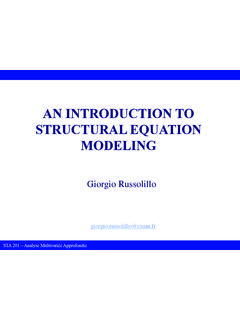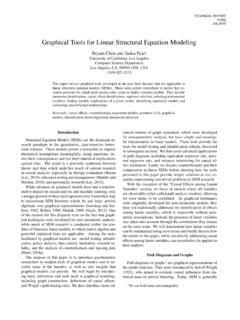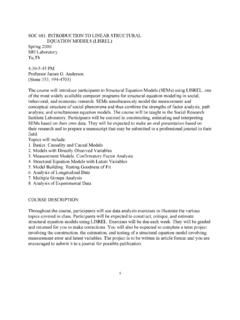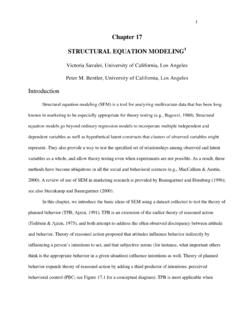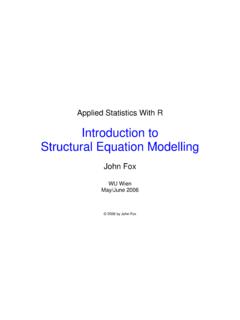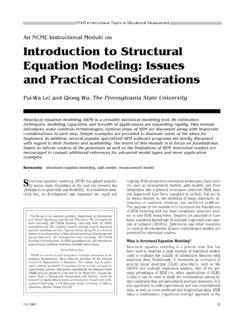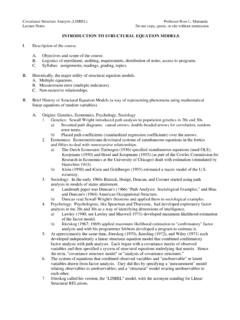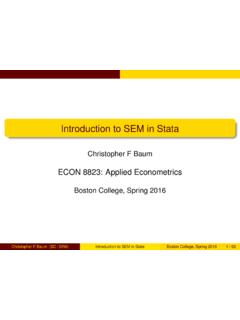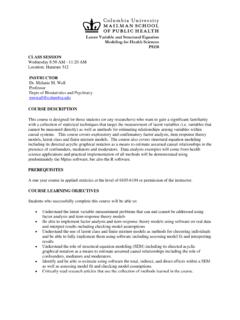Transcription of Introduction to Structural Equation Modeling - CIQSS
1 Introduction to Structural Equation Modeling Location: CIQSS , 3535 Queen-Mary, Suite 420, Montr al Dates: April 20 24, 2015 Financial support for this Data Training School is provided by the Fonds qu b cois de recherche sur la soci t et la culture and the QICSS member institutions1 Trainer The seminar is under the responsibility of Dr. Rex B. Kline, Professor, Department of Psychology, Concordia University; 514-848-2424, ; Eligibility and Registration The course is open to graduate students and postdoctoral fellows as well as to professors and applied researchers. A maximum of 20 participants will be selected by the CIQSS on the basis of the relevance of the course to their curriculum, research, or teaching.
2 Online registration will take place on the CIQSS web site. Contact and registration information: Luc St-Pierre, CIQSS website, Course Description and Content The sessions are in English. This five-day seminar introduces Structural Equation Modeling (SEM). Core SEM techniques, such as path analysis and confirmatory factor analysis (CFA), are covered, and examples of applying SEM to actual research problems are considered. The presentation will be conceptually rather than mathematically oriented. Basic familiarity with multiple regression and exploratory factor analysis is assumed. There is also an opportunity for those with no prior experience using a computer tool for SEM to practice on-site with the student version of LISREL.
3 Even if participants eventually use a different SEM computer tool in their own work, principles learned from working with LISREL will generalize to related applications. Seminar Web Page and Computer Tools From the seminar web page you can download the slides and articles in PDF format and also computer syntax, data, and output files in either text (ASCII) or PDF format for analysis examples. The address is Computer practice sessions use the student version of LISREL for Windows platform computers. It can be freely downloaded from The nyx graphical SEM computer program will be demonstrated. It runs under the Java Runtime Environment (version or later) on Windows, Macintosh, or Linux platform computers and can be freely downloaded from 1 Universit de Montr al, INRS-UCS, McGill University, Concordia University, Universit Laval, Universit du Qu bec, Universit de Sherbrooke.
4 2 Daily Schedule Morning Afternoon 9:15 10:45am Session 1 1:30 3:00pm Session 3 10:45 11:00am Break 3:00 3:15pm Break 11:00am 12:15pm Session 2 3:15 4:45pm Session 4 12:15 1:30pm Lunch Topics and Computer Exercises Computer exercises with LISREL take place on Tuesday and Wednesday from 1:15 1:45pm, and the demonstration with nyx is for Thursday at the same time. Day Topics and exercises M Background concepts, data preparation, types of models, computer tools T Path analysis, estimation, local fit testing LISREL syntax analysis W Global fit testing, comparing hierarchical or non-hierarchical models LISREL graphical editor analysis Th CFA vs. EFA, testing measurement hypotheses, analyzing ordinal data nyx demonstration F SR models, two-step Modeling , reflective vs.
5 Formative measurement Main Source (optional) Kline, R. B. (2015). Principles and practice of Structural Equation Modeling (4th ed.). New York: Guilford Press. (Book resource site for 3rd edition at ) Other Readings (see seminar web page) MacCallum, R. C., & Austin, J. T. (2000). Applications of Structural Equation Modeling in psychological research. Annual Review of Psychology, 51, 201 226. McCoach, D. B., Black, A. C., & O Connell, A. A. (2007). Errors of inference in Structural Equation Modeling . Psychology in the Schools, 44, 461 470. Narayanan, A. (2012). A review of eight software packages for Structural Equation Modeling . American Statistician, 66, 129 138. Shah, R.
6 , & Goldstein, S. M. (2006). Use of Structural Equation Modeling in operations management research: Looking back and forward. Journal of Operations Management, 24, 148 169. Tomarken, A. J., & Waller, N. G. (2005). Structural Equation Modeling : Strengths, limitations, and misconceptions. Annual Review of Clinical Psychology, 1, 31 65. 3 LISREL Practice These exercises are easier if your computer shows file names with extensions. Variable names in LISREL are case sensitive and limited to 8 characters in length. Syntax is executed by clicking on the Run LISREL icon, or . If the analysis is successful, displayed in the Path Diagram window is Chi-Square= , df=5, P-value= , RMSEA= Exercise 1 (Tuesday).
7 LISREL SIMPLIS syntax: 1. Create a new SIMPLIS syntax file: select File | New | Syntax Only, and then save the file as 2. Study the syntax list next for the example path model: o 3. Adapt the syntax just shown for the data and model presented next for N = 373: Exercise 2 (Wednesday). LISREL Path Diagram: 1. Save just the covariances (without labels) in the text file 2. Create a new path diagram: select File | New | Path Diagram, and then save the diagram as 3. These steps will be demonstrated in class, but you can try them on your own: Use the Setup menu to specify the data file, variable names, and sample size before drawing the model on the screen.
8 Check the boxes for the endogenous variables (Observed Y) before dragging and dropping the observed variables from the list to the drawing palette. Select View | Toolbars | Drawing Bar to display the shape tools, if not already visible. 4. When the diagram is finished, select Setup | Build SIMPLIS syntax, and then run it. four-variable example observed variables neg_str cur_prob prob_sol depress covariance matrix sample size is 205 relationships cur_prob = neg_str prob_sol = neg_str cur_prob depress = neg_str cur_prob prob_sol LISREL output: ND = 3 SC RS MI path diagram end of problem exercise, hardy, fitness, stress, illness
